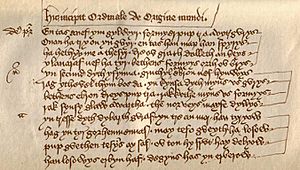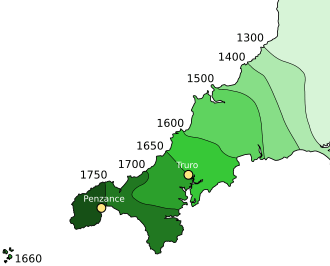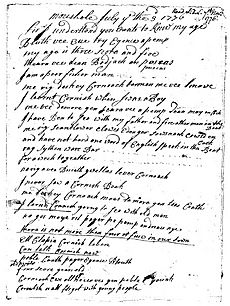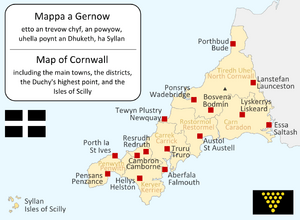Cornish language facts for kids
Quick facts for kids Cornish |
||||
|---|---|---|---|---|
| Kernewek, Kernowek | ||||
| Native to | United Kingdom | |||
| Region | Cornwall | |||
| Ethnicity | Cornish | |||
| Extinct | c. 1777 | |||
| Language family | ||||
| Standard forms | Standard Written Form | |||
| Writing system | Latin alphabet | |||
| Official status | ||||
| Regulated by | Cornish Language Partnership | |||
| Linguist List | cnx Middle Cornish | |||
| oco Old Cornish | ||||
| Linguasphere | 50-ABB-a | |||
|
||||
Cornish (Standard Written Form: Kernewek or Kernowek) is a Southwestern Brittonic language of the Celtic language family. It is a revived language, having become extinct as a first language in Cornwall in 1777. A revival began in the early 20th century. The language is often described as an important part of Cornish identity, culture and heritage. Cornish is currently recognised under the European Charter for Regional or Minority Languages. It has a growing number of second language speakers. A very small number of families now raise children speaking Cornish, which results in first language speakers of revived Cornish.
Along with Welsh and Breton, Cornish is descended directly from the Common Brittonic language spoken throughout much of Great Britain before the English language came to dominate. It was the main language of Cornwall for centuries until it was pushed westwards by English, maintaining close links with its sister language Breton, with which it was mutually intelligible until well into the Middle Ages. Cornish continued to function as a common community language in parts of Cornwall until the mid 18th century. There is some evidence of knowledge of the language persisting into the 19th century, possibly almost overlapping the beginning of revival efforts.
A process to revive the language was begun in the early 20th century, with a number of orthographical systems still in use, although an attempt was made to impose a Standard Written Form in 2008. In 2010, UNESCO announced that its former classification of the language as "extinct" was "no longer accurate". Since the revival of the language, some Cornish textbooks and works of literature have been published, and an increasing number of people are studying the language. Recent developments include Cornish music, independent films and children's books. A small number of people in Cornwall have been brought up to be bilingual native speakers, and the language is taught in schools. The first Cornish language day care opened in 2010.
Contents
Classification
Cornish is one of the Brittonic languages, which constitute a branch of the Insular Celtic section of the Celtic language family. Brittonic also includes Welsh, Breton and the Cumbric language; the last of which is extinct. Scottish Gaelic, Irish and Manx are part of the separate Goidelic branch of Insular Celtic.
Joseph Loth viewed Cornish and Breton as being two dialects of the same language, claiming that "Middle Cornish is without doubt closer to Breton as a whole than the modern Breton dialect of Quiberon [Kiberen] is to that of Saint-Pol-de-Léon [Kastell-Paol]."
History
Cornish evolved from the Common Brittonic spoken throughout Britain south of the Firth of Forth during the British Iron Age and Roman period. As a result of westward Anglo-Saxon expansion, the Britons of the southwest were separated from those in modern-day Wales and Cumbria. Some scholars have proposed that this split took place after the Battle of Deorham in about 577. The western dialects eventually evolved into modern Welsh and the now extinct Cumbric, while Southwestern Brittonic developed into Cornish and Breton, the latter as a result of emigration to parts of the continent, known as Brittany over the following centuries.
Old Cornish
The area controlled by the southwestern Britons was progressively reduced by the expansion of Wessex over the next few centuries. During the Old Cornish period (800–1200), the Cornish-speaking area was largely coterminous with modern-day Cornwall, after the Saxons had taken over Devon in their south-westward advance, which probably was facilitated by a second migration wave to Brittany that resulted in the partial depopulation of Devon. The earliest written record of the Cornish language comes from this period; a 9th-century gloss in a Latin manuscript of De Consolatione Philosophiae by Boethius, which used the words ud rocashaas. The phrase means "it [the mind] hated the gloomy places". A much more substantial survival from Old Cornish is a Cornish-Latin glossary (the Vocabularium Cornicum or Cottonian Vocabulary) containing translations of around 940 entries, of which 503 are definitely Cornish, 305 could be either Cornish or Welsh, 38 are Welsh or show certain features of Welsh, and 94 are 'not Brittonic', or of unknown origin, according to a study by Oliver Padel. The manuscript was widely thought to be in Old Welsh until the 18th century when it was identified as Cornish. At this time there was still little difference between Welsh and Cornish, and even fewer differences between Cornish and Breton, with some scholars arguing that the terms "Old Cornish" and "Old Breton" are merely geographical terms for the same language. Some Brythonic glosses in the 9th-century colloquy De raris fabulis were once identified as Old Cornish, but they are more likely Old Welsh, possibly influenced by a Cornish scribe.
Middle Cornish
The Cornish language continued to flourish well through the Middle Cornish period (1200–1600), reaching a peak of about 39,000 speakers in the 13th century, after which the number started to decline. This period provided the bulk of traditional Cornish literature, which was used to reconstruct the language during its revival. Most important is the Ordinalia, a cycle of three mystery plays, Origo Mundi, Passio Christi and Resurrexio Domini. Together these provide about 20,000 lines of text. Various plays were written by the canons of Glasney College, intended to educate the Cornish people about the Bible and the Celtic saints. From this period also are the plays Beunans Meriasek and the recently discovered Bewnans Ke.
In the reign of Henry VIII, an account was given by Andrew Boorde in his 1542 Boke of the Introduction of Knowledge. He states, "In Cornwall is two speches, the one is naughty Englysshe, and the other is Cornysshe speche. And there be many men and women the which cannot speake one worde of Englysshe, but all Cornyshe."
When Parliament passed the Act of Uniformity 1549, people in many areas of Cornwall did not speak or understand English. The intention of the Act was to replace worship in Latin with worship in English, which was known by the lawmakers not to be universally spoken throughout England. Instead of merely banning Latin, the Act was framed so as to enforce English. The Prayer Book Rebellion, which may also have been influenced by the retaliation of the English after the failed Cornish Rebellion of 1497, broke out, and was ruthlessly suppressed: over 4,000 people who protested against the imposition of an English prayer book were massacred by Edward VI's army. Their leaders were executed and the people suffered numerous reprisals.
The rebels' document claimed they wanted a return to the old religious services and ended, "We the Cornishmen (whereof certain of us understand no English) utterly refuse this new English [altered spelling]." Edward Seymour, Duke of Somerset, replied to the Cornishmen, inquiring as to why they should be offended by services in English when they had them in Latin, which they also did not understand.
Through many factors, including loss of life and the spread of English, the Prayer Book Rebellion proved a turning-point for the Cornish language. Peter Berresford Ellis cites the years 1550–1650 as a century of immense damage for the language, and its decline can be traced to this period. In 1680, William Scawen wrote an essay describing 16 reasons for the decline of Cornish, among them the lack of a distinctive Cornish alphabet, the loss of contact between Cornwall and Brittany, the cessation of the miracle plays, loss of records in the Civil War, lack of a Cornish Bible, and immigration to Cornwall.
Early Modern Cornish
By the middle of the 17th century, the language had retreated to Penwith and Kerrier, and transmission of the language to new generations had almost entirely ceased. In his Survey of Cornwall, published in 1602, Richard Carew writes:
[M]ost of the inhabitants can speak no word of Cornish, but very few are ignorant of the English; and yet some so affect their own, as to a stranger they will not speak it; for if meeting them by chance, you inquire the way, or any such matter, your answer shall be, "Meea navidna caw zasawzneck," "I [will] speak no Saxonage."
The Late Cornish period from 1578 to about 1800 has fewer sources of information on the language but they are more varied in nature. Written sources from this period are often spelled following English spelling conventions since the majority of writers of the time had had no exposure to Middle Cornish texts or the Cornish orthography within them, although after 1700 some writers began to adopt the orthography used by Edward Lhuyd in his Archaeologia Britannica, for example using the circumflex to denote long vowels. In 1776, William Bodinar, who had learnt Cornish from fishermen, wrote a letter in Cornish which was probably the last prose in the language. However, the last verse was the Cranken Rhyme, written in the late 19th century by John Davey of Boswednack. John Kelynack (1796–1885), a fisherman of Newlyn, was sought by philologists for old Cornish words and technical phrases in the 19th-century.
Decline of Cornish speakers between 1300 and 1800
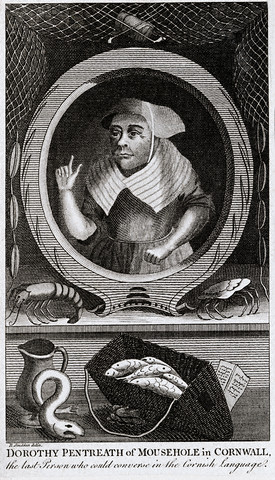
The traditional view that Dolly Pentreath (1692–1777) was the last native speaker of Cornish has been challenged, and in the 18th and 19th centuries, there was academic interest in the language and in attempting to find the last speaker of Cornish. The search for the last speaker is hampered by a lack of transcriptions or audio recordings, so that it is impossible to tell, from this distance, whether the language these people were reported to be speaking was Cornish, or English with a heavy Cornish substratum, nor what their level of fluency was. Nevertheless this academic interest, along with the beginning of the Celtic Revival in the late 19th century, provided the groundwork for a Cornish language revival movement.
Notwithstanding the uncertainty over who was the last speaker of Cornish, researchers have posited the following numbers for the prevalence of the language between 1050 and 1800.
| Year | Area where Cornish was spoken (in km²) |
Total population of Cornwall |
Number of Cornish speakers |
|---|---|---|---|
| 1050 | 16,000 | 15,000 | |
| 1110 | 21,000 | 20,000 | |
| 1150 | 28,000 | 26,000 | |
| 1200 | 3,270 | 35,000 | 30,000 |
| 1250 | 43,000 | 34,000 | |
| 1300 | 2,780 | 52,000 | 38,000 |
| 1350 | 48,000 | 32,000 | |
| 1400 | 2,360 | 55,000 | 34,000 |
| 1450 | 2,360 | 62,000 | 33,000 |
| 1500 | 1,890 | 69,000 | 33,000 |
| 1550 | 76,000 | 30,000 | |
| 1600 | 1,400 | 84,000 | 22,000 |
| 1650 | 910 | 93,000 | 14,000 |
| 1700 | 530 | 106,000 | 5,000 |
| 1750 | 160 | 140,000 | "Very few" |
| 1800 | 0 | 192,000 | 0 |
Recent Modern Cornish
In 1904, the Celtic language scholar and Cornish cultural activist Henry Jenner published A Handbook of the Cornish Language. The publication of this book is often considered to be the point at which the revival movement started.
The revival focused on reconstructing and standardising the language, including coining new words for modern concepts, and creating educational material in order to teach Cornish to others. In 1929 Robert Morton Nance published his Unified Cornish system, based on the Middle Cornish literature while extending the attested vocabulary with forms based on Celtic roots also found in Breton and Welsh, publishing a dictionary in 1938. Nance's work became the basis of revived Cornish for most of the 20th century. However, as the revival grew in strength and focus shifted from written to spoken Cornish, Nance's stiff, archaic formulation of the language seemed less suitable for a spoken revival, and academic research into the traditional literature proved that the Unified system lacked some phonological distinctions.
In the 1980s, in response to dissatisfaction with Unified Cornish, Ken George published a new system, Kernewek Kemmyn ("Common Cornish"). Like Unified Cornish, it retained a Middle Cornish base but implemented an orthography that aspired to be as phonemic as possible. It was subsequently adopted by the Cornish Language Board as well as by many Cornish speakers, but came under fierce criticism for a variety of reasons by Jon Mills and Nicholas Williams, as well as those who found its orthography too different from traditional Cornish spelling conventions. Also during this period, Richard Gendall created his Modern Cornish system (also known as "Revived Late Cornish"), which used Late Cornish as a basis, and Nicholas Williams published a revised version of Unified; however neither of these systems gained the popularity of Unified or Kemmyn.
The revival entered a period of factionalism and public disputes, with each orthography attempting to push the others aside. By the time that Cornish was recognised by the UK government under the European Charter for Regional or Minority Languages in 2002, it had become recognised that the existence of multiple orthographies was unsustainable with regards to using the language in education and public life, as none had achieved a wide consensus. A process of unification was set about which resulted in the creation of the public-body Cornish Language Partnership in 2005 and agreement on a Standard Written Form in 2008. In 2010 a new milestone was reached when UNESCO altered its classification of Cornish, stating that its previous label of "extinct" was no longer accurate.
Geographic distribution and number of speakers
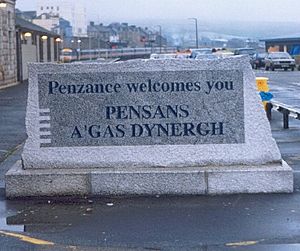
Speakers of Cornish reside primarily in Cornwall, which has a population of 563,600 (2017 estimate). There are also some speakers living outside Cornwall, particularly in the countries of the Cornish diaspora, as well as other Celtic nations. Estimates of the number of Cornish speakers vary according to the definition of being a speaker, and is difficult to accurately determine due to the individualised nature of language take-up. Nevertheless, there is recognition that the number of Cornish speakers is growing. From before the 1980s to the end of the 20th century there was a sixfold increase in the number of speakers to around 300. One figure for the mean number of people who know a few basic words, such as knowing that "Kernow" means "Cornwall", was 300,000; the same survey gave the figure of people able to have simple conversations at 3,000.
The Cornish Language Strategy project commissioned research to provide quantitative and qualitative evidence for the number of Cornish speakers: due to the success of the revival project it was estimated that 2,000 people were fluent (surveyed in spring 2008), an increase from the estimated 300 people who spoke Cornish fluently suggested in a study by Kenneth MacKinnon in 2000.
Jenefer Lowe of the Cornish Language Partnership said in an interview with the BBC in 2010 that there were around 300 fluent speakers. Councillor and Bard Bert Biscoe in a statement to Western Morning News in 2014 said there were "several hundred fluent speakers. Cornwall Council estimated in 2015 that there were 300–400 fluent speakers who used the language regularly, with 5,000 people having a basic conversational ability in the language.
A report on the 2011 Census published in 2013 by the Office for National Statistics placed the number of speakers at somewhere from 325 to 625 speakers. In 2017 the ONS released a freedom of information request based on the 2011 Census which placed the number of speakers at 557 people in England and Wales declared Cornish to be their main language, 464 of whom lived in Cornwall.
A study which appeared in 2018 established the number of people in Cornwall with at least minimal skills in Cornish, such as the use of some words and phrases, to be more than 3,000, including around 500 estimated to be fluent.
The Institute of Cornish Studies at the University of Exeter is working with the Cornish Language Partnership to study the Cornish language revival of the 20th Century, including the growth in number of speakers.
Legal status and recognition
Cornish has had no official status but has attracted elements of recognition internationally and within the UK.
International recognition
In 2002, it was named as a regional or minority language under the European Charter for Regional or Minority Languages. UNESCO's Atlas of World Languages classifies Cornish as "critically endangered." UNESCO has said that a previous classification of "extinct", which came under fierce criticism from Cornish speakers, "does not reflect the current situation for Cornish".
Within the UK
Cornwall Council's policy is to support the language, in line with the European Charter. A motion was passed in November 2009 in which the council promoted the inclusion of Cornish, as appropriate and where possible, in council publications and on signs. This plan has drawn some criticism. In October 2015, Cornwall Council announced that staff would be encouraged to use "basic words and phrases" in Cornish when dealing with the public. In 2021 Cornwall Council prohibited a marriage ceremony from being conducted in Cornish as the Marriage Act 1949 only allowed for marriage ceremonies in English or Welsh.
In 2014 the Cornish people were recognised by the UK Government as a national minority under the Framework Convention for the Protection of National Minorities. The FCNM provides certain rights and protections to a national minority with regard to their minority language.
In 2016, British government funding for the Cornish language ceased, and responsibility transferred to Cornwall Council.
Phonology
The phonology of modern Cornish is based on a number of sources. The work of the linguist Edward Lhuyd, who visited Cornwall in 1700 to record the language, has provided a major source of input. Analysis of the traditional literature has also been used, as the Middle Cornish plays were often written in rhyming verse, and Late Cornish texts were written phonetically following English spelling conventions.
Grammar
The grammar of Cornish shares with other Celtic languages a number of features which, while not unique, are unusual in an Indo-European context. The grammatical features most unfamiliar to English speakers of the language are the initial consonant mutations, the verb–subject–object word order, inflected prepositions, fronting of emphasised syntactic elements, and the use of two different forms for "to be". Cornish nouns belong to one of two grammatical genders, masculine and feminine, but are not inflected for case. Cornish has a variety of different endings to indicate the plural, and some nouns have a third collective form. Verbs are conjugated for tense and mood, which can be indicated either by inflection of the main verb, or by the use of auxiliary verbs. In Cornish vocabulary, a large number of the lexical items are language and culture-specific. Examples of these include the Cornish word atal, which means "mine waste" and the word beetia, which means "to mend fishing nets". Foogan and hogan are different types of pastry cakes. Troyl is culture-specific when referring to "a traditional Cornish dance get-together", while Furry is a specific kind of ceremonial dance that takes place in Cornwall.
In contrast, Cornish translates the English noun, "book", as lyver (= Welsh llyfr), but lyver can actually be translated into English as "book" or "volume" because it can be considered one in a set of books.
As in other Celtic languages, Cornish lacks a number of verbs that are commonly found in other languages. This includes modals and psych-verbs; examples are "have", "like", "hate", "prefer", "must"/"have to", "make"/"compel to". These functions are instead fulfilled by periphrastic constructions involving a verb and various prepositional phrases.
- Initial consonant mutation: The first sound of a Cornish word may change according to grammatical context. As in Breton, there are four types of mutation in Cornish (compared to three in Welsh, two in Irish and Manx, and one in Scottish Gaelic). These are known as soft (b > v, etc.), hard (b > p), aspirate (b unchanged, t > th) and mixed (b > f).
| Unmutated consonant |
Soft mutation |
Aspirate mutation |
Hard mutation |
Mixed mutation |
|---|---|---|---|---|
| p | b | f | - | - |
| t | d | th | - | - |
| k | g | h | - | - |
| b | v | - | p | f |
| d | dh | - | t | t |
| g1 | disappears | - | k | h |
| g2 | w | - | k | hw |
| gw | w | - | kw | hw |
| m | v | - | - | f |
| ch | j | - | - | - |
| 1 Before unrounded vowels (i, y, e, a), l, and r + unrounded vowel. 2 Before rounded vowels (o, u), and r + rounded vowel. |
||||
- inflected (or conjugated) prepositions: A preposition combines with a personal pronoun to give a separate word form. For example, gans (with, by) + my (me) → genev; gans + ev (him) → ganso.
- No indefinite article. Porth means "harbour" or "a harbour" (there is, however, a definite article: an porth means "the harbour").
Culture
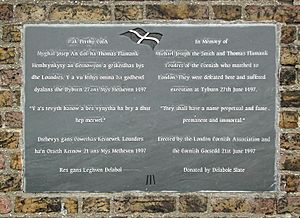
The Celtic Congress and Celtic League are groups that advocate cooperation amongst the Celtic Nations in order to protect and promote Celtic languages and cultures, thus working in the interests of the Cornish language.
There have been films such as Hwerow Hweg, some televised, made entirely, or significantly, in the language. Some businesses use Cornish names.
According to sociolinguist Kenneth MacKinnon, Jenner wrote "There has never been a time when there has been no person in Cornwall without a knowledge of the Cornish language."
Cornish has significantly and durably affected Cornwall's place-names, as well as in Cornish surnames, and knowledge of the language helps the understanding of these ancient meanings. Cornish names are adopted for children, pets, houses and boats.
There is Cornish literature, including spoken poetry and song, as well as traditional Cornish chants historically performed in marketplaces during religious holidays and public festivals and gatherings.
There are periodicals solely in the language such as the monthly An Gannas, An Gowsva, and An Garrick. BBC Radio Cornwall has a news broadcast in Cornish, and sometimes has other programmes and features for learners and enthusiasts. Local newspapers such as the Western Morning News have articles in Cornish, and newspapers such as The Packet, The West Briton and The Cornishman have also been known to have Cornish features. There is an online radio service in Cornish called Radyo an Gernewegva, publishing a one-hour podcast each week, based on a magazine format. It includes music in Cornish as well as interviews and features.
The language has financial sponsorship from sources, including the Millennium Commission. A number of language organisations exist in Cornwall: Agan Tavas (Our Language), the Cornish sub-group of the European Bureau for Lesser-Used Languages, Gorsedh Kernow, Kesva an Taves Kernewek (the Cornish Language Board) and Kowethas an Yeth Kernewek (the Cornish Language Fellowship). There are ceremonies, some ancient, some modern, which use the language or are entirely in the language.
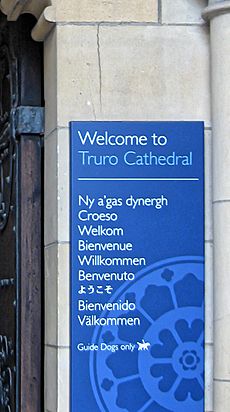
Cultural events
Though estimations of the number of Cornish speakers vary, the speakers of Cornish today are thought to be around five hundred. Currently, Cornish is spoken by its speakers at home, outside the home, in the workplace, and at ritual ceremonies. Cornish is also being used in the arts. Revived Cornish is constructed on historical Cornish, so that the Cornish language develops. English language has had some effect in this development. Regardless of having "no concrete purpose during the twentieth century," the number of Cornish speakers has gradually increased.
The Celtic Congress and Celtic League are groups that advocate cooperation amongst the Celtic Nations in order to protect and promote Celtic languages and cultures, thus working in the interests of the Cornish language. Cornish has significantly and durably affected Cornwall's place-names, as well as in Cornish surnames, and knowledge of the language helps the understanding of these ancient meanings. Cornish names are adopted for children, pets, houses and boats. There are periodicals solely in the language such as the monthly An Gannas, An Gowsva, and An Garrick. BBC Radio Cornwall has a news broadcast in Cornish, and sometimes has other programmes and features for learners and enthusiasts. Local newspapers such as the Western Morning News have articles in Cornish, and newspapers such as The Packet, The West Briton and The Cornishman have also been known to have Cornish features. The language has financial sponsorship from sources, including the Millennium Commission. A number of language organisations exist in Cornwall: Agan Tavas (Our Language), the Cornish sub-group of the European Bureau for Lesser-Used Languages, Gorsedh Kernow, Kesva an Taves Kernewek (the Cornish Language Board) and Kowethas an Yeth Kernewek (the Cornish Language Fellowship).
Cornwall has had cultural events associated with the language, including the international Celtic Media Festival, hosted in St Ives in 1997. The Old Cornwall Society has promoted the use of the language at events and meetings. Two examples of ceremonies that are performed in both the English and Cornish languages are Crying the Neck and the annual mid-summer bonfires.
Study and teaching
Cornish is taught in some schools; it was previously taught at degree level at the University of Wales, though the only existing course in the language at University level is as part of a course in Cornish Studies at the University of Exeter. In March 2008, a course in the language was started as part of the Celtic Studies curriculum at the University of Vienna, Austria. The University of Cambridge offers courses in Cornish through its John Trim Resources Centre, which is part of its Language Centre. In addition, the Department of Anglo-Saxon, Norse and Celtic (which is part of the faculty of English), also carries out research into the Cornish language.
In 2015 a university level course aiming to encourage and support practitioners working with young children to introduce the Cornish language into their settings was launched. The Cornish Language Practice Project (Early Years) is a level 4 course approved by Plymouth University and run at Cornwall College. The course is not a Cornish language course, but students will be assessed on their ability to use the Cornish language constructively in their work with young children. The course will cover such topics as Understanding Bilingualism, Creating Resources and Integrating Language and Play, but the focus of the language provision will be on Cornish. A non-accredited specialist Cornish language course has been developed to run alongside the level 4 course for those who prefer tutor support to learn the language or develop their skills further for use with young children.
Cornwall's first Cornish language crèche, Skol dy'Sadorn Kernewek, was established in 2010 at Cornwall College, Camborne. The nursery teaches children aged between two and five years alongside their parents to ensure the language is also spoken in the home.
A number of dictionaries are available in the different orthographies (a dictionary in the Standard Written Form has yet to be published), including An Gerlyver Meur by Ken George, Gerlyver Sawsnek–Kernowek by Nicholas Williams and A Practical Dictionary of Modern Cornish by Richard Gendall. Course books include the three-part Skeul an Yeth series, Clappya Kernowek, Tavas a Ragadazow and Skeul an Tavas, as well as the more recent Bora Brav and Desky Kernowek.
Classes and conversation groups for adults are available at several locations in Cornwall, as well as in London, Cardiff and Bristol.
Cornish studies
William Scawen produced a manuscript on the declining Cornish language that continually evolved until he died in 1689, aged 89. He was one of the first to realise the language was dying out and wrote detailed manuscripts which he started working on when he was 78. The only version that was ever published was a short first draft, but the final version, which he worked on until his death, is a few hundred pages long. At the same time a group of scholars, led by John Keigwin (nephew of William Scawen), of Mousehole, tried to preserve and further the Cornish language, and chose to consciously write in Cornish. One of their number, Nicholas Boson, tells how he had formerly been discouraged from using Cornish to servants by his mother. This group left behind a large number of translations of parts of the Bible, proverbs and songs. They were contacted by the Welsh linguist Edward Lhuyd who came to Cornwall to study the language.
Early Modern Cornish was the subject of a study published by Lhuyd in 1707, and differs from the medieval language in having a considerably simpler structure and grammar. Such differences included sound changes and more frequent use of auxiliary verbs. The medieval language also possessed two additional tenses for expressing past events and an extended set of possessive suffixes.
John Whitaker, the Manchester-born rector of Ruan Lanihorne, studied the decline of the Cornish language. In his 1804 work the Ancient Cathedral of Cornwall he concluded that: "[T]he English Liturgy, was not desired by the Cornish, but forced upon them by the tyranny of England, at a time when the English language was yet unknown in Cornwall. This act of tyranny was at once gross barbarity to the Cornish people, and a death blow to the Cornish language."
Robert Williams published the first comprehensive Cornish dictionary in 1865, the Lexicon Cornu-Britannicum. As a result of the discovery of additional ancient Cornish manuscripts, 2000 new words were added to the vocabulary by Whitley Stokes in A Cornish Glossary. William C. Borlase published Proverbs and Rhymes in Cornish in 1866 while A Glossary of Cornish Names was produced by John Bannister in the same year. Frederick Jago published his English–Cornish Dictionary in 1882.
In 2002, the Cornish language gained new recognition because of the European Charter for Regional and Minority Languages. Conversely, along with government provision was the governmental basis of "New Public Management," measuring quantifiable results as means of determining effectiveness. This put enormous pressure on finding a single orthography that could be used in unison. The revival of Cornish required extensive rebuilding. The Cornish orthographies that were reconstructed may be considered versions of Cornish because they are not traditional sociolinguistic variations. In the middle-to-late twentieth century, the debate over Cornish orthographies angered more people because several language groups received public funding. This caused other groups to sense favouritism as playing a role in the debate.
A governmental policymaking structure called New Public Management (NPM) has helped the Cornish language by managing public life of the Cornish language and people. In 2007, the Cornish Language Partnership MAGA represents separate divisions of government and their purpose is to further enhance the Cornish Language Developmental Plan. MAGA established an "Ad-Hoc Group," which resulted in three orthographies being presented. The relations for the Ad-Hoc Group were to obtain consensus among the three orthographies, and then develop a "single written form." The end result was creating a new form of Cornish, which had to be natural for both new learners and skilled speakers.
Literature
Recent Modern Cornish literature
In 1981, the Breton library Preder edited Passyon agan arluth (Passion of our lord), a 15th-century Cornish poem. The first complete translation of the Bible into Cornish, translated from English, was published in 2011. Another Bible translation project translating from original languages is underway. The New Testament and Psalms were posted on-line on YouVersion (Bible.com) and Bibles.org in July 2014 by the Bible Society.
A few small publishers produce books in Cornish which are stocked in some local bookshops, as well as in Cornish branches of Waterstones and WH Smith, although publications are becoming increasingly available on the Internet. Printed copies of these may also be found from Amazon. The Truro Waterstones hosts the annual "Holyer an Gof" literary awards, established by Gorsedh Kernow to recognise publications relating to Cornwall or in the Cornish language. In recent years, a number of Cornish translations of literature have been published, including Alice's Adventures in Wonderland (2009), Around the World in Eighty Days (2009), Treasure Island (2010), The Railway Children (2012), Hound of the Baskervilles (2012), The War of the Worlds (2012), The Wind in the Willows (2013), Three Men in a Boat (2013), Alice in Wonderland and Through the Looking-Glass (2014), and A Christmas Carol (which won the 2012 Holyer an Gof award for Cornish Language books), as well as original Cornish literature such as Jowal Lethesow (The Lyonesse Stone) by Craig Weatherhill. Literature aimed at children is also available, such as Ple'ma Spot? (Where's Spot?), Best Goon Brèn (The Beast of Bodmin Moor), three Topsy and Tim titles, two Tintin titles and Briallen ha'n Alyon (Briallen and the Alien), which won the 2015 Holyer an Gof award for Cornish Language books for children. In 2014 An Hobys, Nicholas Williams' translation of J. R. R. Tolkien's The Hobbit was published.
An Gannas is a monthly magazine published entirely in the Cornish language. Members contribute articles on various subjects. The magazine is produced by Graham Sandercock who has been its editor since 1976.
Media
In 1983 BBC Radio Cornwall started broadcasting around two minutes of Cornish every week. In 1987, however, they gave over 15 minutes of airtime on Sunday mornings for a programme called Kroeder Kroghen ("Holdall"), presented by John King, running until the early 1990s. It was eventually replaced with a five-minute news bulletin called An Nowodhow ("The News"). The bulletin was presented every Sunday evening for many years by Rod Lyon, then Elizabeth Stewart, and currently a team presents in rotation. Pirate FM ran short bulletins on Saturday lunchtimes from 1998 to 1999. In 2006, Matthew Clarke who had presented the Pirate FM bulletin, launched a web-streamed news bulletin called Nowodhow an Seythen ("Weekly News"), which in 2008 was merged into a new weekly magazine podcast Radyo an Gernewegva (RanG).
Cornish television shows have included a 1982 series by Westward Television each episode containing a three-minute lesson in Cornish. An Canker-Seth, an eight episode series produced by Television South West and broadcast between June and July 1984, later on S4C from May to July 1985, and as a schools programme in 1986. Also by Television South West were two bilingual programmes on Cornish Culture called Nosweyth Lowen In 2016 Kelly's Ice Cream of Bodmin introduced a light hearted television commercial in the Cornish language and this has been repeated in 2017.
The first episode from the third season of the US television program Deadwood features a conversation between miners in the Cornish language, including a toast of shots using "sláinte", a term also common in the Irish language. One of the miners is then shot by thugs working for businessman George Hearst and justifies the murder by saying, "He come at me with his foreign gibberish."
Music
English composer Peter Warlock wrote a Christmas carol in Cornish (setting words by Henry Jenner). The Cornish electronic musician Aphex Twin has used Cornish names for track titles, most notably on his DrukQs album.
Several traditional Cornish folk songs have been collected and can be sung to various tunes. These include "An Awhesyth", "Bro Goth agan Tasow", and "Delkiow Sivy".
In 2018, the singer Gwenno Saunders released an album in Cornish, entitled Le Kov, saying: "I speak Cornish with my son: if you’re comfortable expressing yourself in a language, you want to share it."
Place-names and surnames
The Cornish language has influenced the toponomy of Cornwall, and has historically been used in surnames for the Cornish people. Long before the agreement of the Standard Written Form of Cornish in the 21st century, Late Cornish orthography in the Early Modern period usually followed Welsh to English transliteration, phonetically rendering C for K, I for Y, U for W, and Z for S. This meant that place-names were adopted into English with spellings such as "Porthcurno" and "Penzance"; they are written Porth Kernow and Pen Sans in the Standard Written Form of Cornish, agreed upon in 2008. Likewise, words such as Enys ("island") can be found spelled as "Ince" as at Ince Castle. These apparent mistransliterations can however reveal an insight into how names and places were actually pronounced, explaining, for example, how anglicised Launceston is still pronounced "Lann-zan" from Cornish "Lann Stefan" (though with emphasis on the first element, the result of accent shift in English, and a consonant change s > z which again would have occurred in English in this alternative English form of the name).
The following tables present some examples of Cornish place-names and surnames, and their anglicised versions:
|
|
Samples
From the Universal Declaration of Human Rights:
| Cornish | Translation |
|---|---|
| Genys frank ha par yw oll tus an bys | All human beings are born free and |
| yn aga dynita hag yn aga gwiryow. | equal in dignity and rights. They are |
| Enduys yns gans reson ha kowses | endowed with reason and conscience |
| hag y tal dhedha omdhon an eyl orth | and should act towards one another |
| y gila yn spyrys a vrederedh. | in a spirit of brotherhood. |
From Bro Goth agan Tasow, the Cornish anthem:
| Cornish | Translation |
|---|---|
| Bro goth agan tasow, dha fleghes a'th kar, | Old land of our fathers, your children love you, |
| Gwlas ker an howlsedhes, pan vro yw dha bar? | Dear country of the west, what land is your equal? |
| War oll an norvys 'th on ni skollys a-les, | Over all the world, we are spread far and wide, |
| Mes agan kerensa yw dhis. | But our love is for you. |
| Kernow, Kernow y keryn Kernow; | Cornwall, Cornwall, we love Cornwall; |
| An mor hedre vo yn fos dhis a-dro | For as long as the sea is a wall around you |
| Th on onan hag oll rag Kernow! | We are one and all for Cornwall! |
Images for kids
-
Dolly Pentreath (died 1777), said to be the last monolingual speaker of Cornish, in an engraved portrait published in 1781
See also
 In Spanish: Idioma córnico para niños
In Spanish: Idioma córnico para niños



